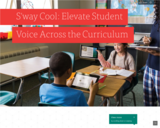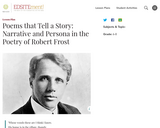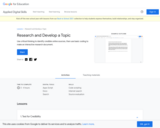Students use the Informational Text Analysis Tool to deconstruct the essential elements of informational text.
- Subject:
- Secondary English Language Arts
- Material Type:
- Lesson Plan
- Author:
- Utah Lesson Plans
- Date Added:
- 02/03/2022
Students use the Informational Text Analysis Tool to deconstruct the essential elements of informational text.

This lesson plan meets the secondary requirements for The Engish Language Arts Standard Reading: Literature Grades 7-12 with the option of meeting the additional standard of Speaking and Listening. This lesson offers specific details with flexibility for implementation in the classroom. Students can work independently or in groups and be able to create their final book project using technology.

Students investigate the effects of word choice in Robert Frost's "Choose Something Like a Star" to construct a more sophisticated understanding of speaker, subject, and tone.

This lesson will help students learn from four different scholastic scope articles about digital citizenship. Students will learn one article and teach others about it so then by the end they will understand all four articles. They will present the information by doing a choice board with their group to decide how they want to present the information.

Students will learn the potential costs and benefits of social media, digital consumption, and our relationship with technology as a society in the three-week lesson. This inquiry based unit of study will answer the following questions:
Essential Question: How can we use science fiction’s ability to predict the future to help humanity?
Supportive Questions 1: What predictions of future development has science fiction accurately made in the past? This can include technology, privacy, medicine, social justice, political, environmental, education, and economic.
Supportive Question 2: What predictions for future development in contemporary science fiction are positive for the future of humanity? What factors need to begin in your lifetime to make these predictions reality?
Supportive Question 3: What predictions for future development in contemporary science fiction are negative for the future of humanity? What factors need to begin in your lifetime to stop these negative outcomes?
(Thumbnail is a screenshot of the OER Commons lesson page, taken 7/26/2022 by Christina Nelson.)

Students will engage with primary source documents to explore the reasons behind memorializing people in public art. Students will craft written or oral statements to support an argument in favor of installing a statue of Dr. Martha Hughes Cannon, Philo T. Farnsworth, or Brigham Young in National Statuary Hall.

When students are given the opportunity to express themselves, they need creative options and a variety of formats available to meet their needs. See how AI supports the student's content through design and publishing process in tools like Sway and Stream to allow students to share professionally designed work without wasting time and energy on executive tasks.

Students will dive into research on different aspect of Elizabethan England in order to gain context and background knowlege on William Shakespeare's time prior to a Shakespeare unit in ELA.

Phillis Wheatley was born around the year 1753 in West Africa before she was kidnapped and brought to the West Indies where she was enslaved. In 1773, the same year she became free from enslavement, she became the first African American and first enslaved person in American history to publish a book of poems. In this lesson, students imagine that a possible meeting between George Washington and Wheatley in 1776 actually occurred and compose questions for them both. Access to this resource requires a free educator login.

Learn how to make inferences in literature, nonfiction and real life, and to support those inferences with strong, reliable evidence.Preview Image is "thinking cap" by Joe in DC

Behind many of the apparently simple stories of Robert Frost's poems are unexpected questions and mysteries. In this lesson, students analyze what speakers include or omit from their narrative accounts, make inferences about speakers' motivations, and find evidence for their inferences in the words of the poem.

Students learn how to research and develop a topic for a student choice project.

Scrible PDF Viewer/Annotator Video

Scrible Product Explainer Video

This lesson plan encourages classroom discussions and reflections on cultural norms, mores, and folkways and uses the coloring sheet and poem: "S is for Shoes Off in the House" to propel critical thinking about students' own cultures in relation to others and how we can show respect, tolerance, and acceptance.

Students prepare for interviews by reviewing what they know about the sources, conducting pre-interviews, creating a list of questions for the recorded interviews, and making a shot list. They will also identify locations for the interviews and decide which members of the group will conduct the interviews.

Adding assignments for students to complete has never been easier with Scrible!

Let’s learn about importing existing courses from Google Classroom, Canvas, or Office365 to Scrible or create a new Scrible class!

There are many ways to use a tool like Scrible in your classroom. Let’s explore some options for using Scrible in our classrooms!

Let’s explore how to create a library of sources to use in our research projects! Join UEN’s Scrible MOOC course today at UEN’s Course Catalog.